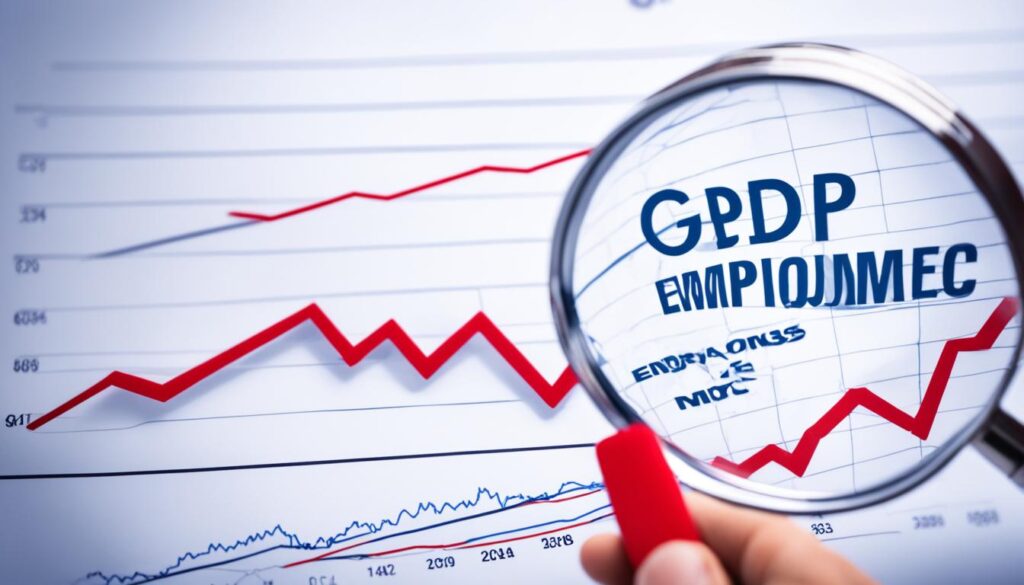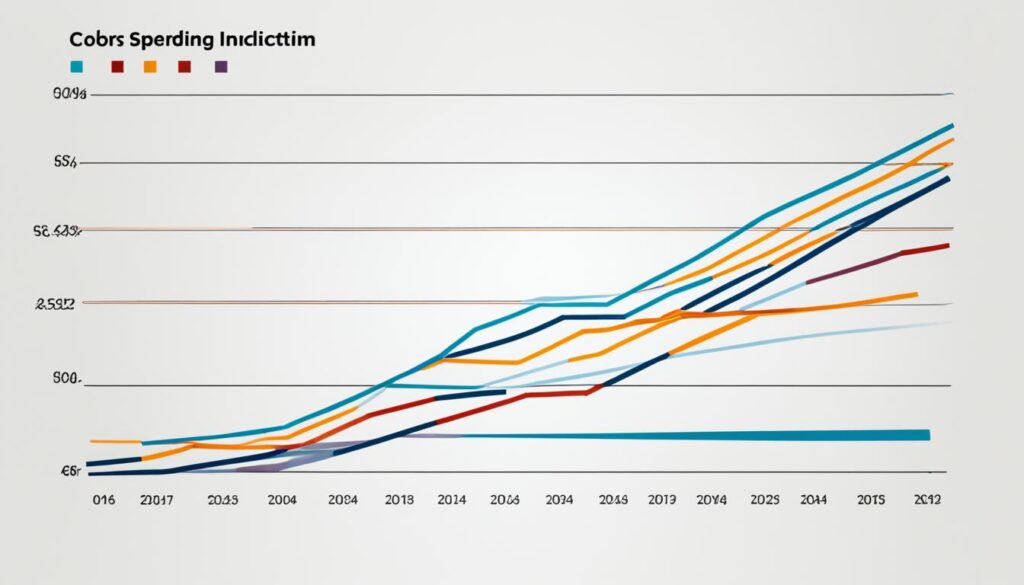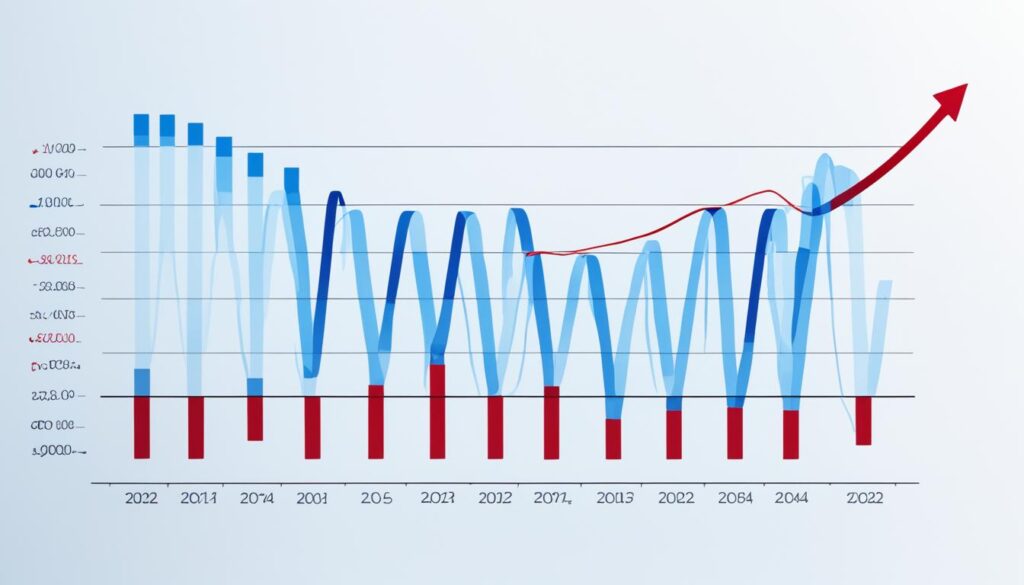“As an Amazon Associate I earn from qualifying purchases.”
As you sip your morning coffee and look at the news, you might wonder if the US is heading for a recession in 2024. The stock market’s ups and downs in 2022 may still be fresh in your mind. You might worry about your money, investments, and job. Many people are concerned. They’re talking about the Federal Reserve’s interest rates, how much people are spending, and jobs. Financial experts are looking closely at these things. They’re trying to predict if a recession is coming or if things will take a different turn.
It’s hard to plan for the future with so many guesses about interest rates. Experts first thought the Federal Reserve would cut rates three times. Now, it seems like we might only get one or two cuts. This makes figuring out the economy even harder. Consumer spending is down, but there are still some good signs. The S&P 500 index has gone up more than 26% in 2023. It reached a new high in early 2024. But, prices keep going up, making things more complicated for everyone.
People are really feeling the pinch from high prices. They’re about 19% higher since President Joe Biden started his term. Looking at the big picture—like the economy’s growth, the stock market, and jobs—can give us clues about where the economy is headed. The Federal Reserve now thinks the economy will grow by 2.1% in 2024. This is better than their earlier guess of 1.4%. But, a survey found that over 41% of experts think high interest rates are the biggest threat to the economy.
Key Takeaways:
- The Federal Reserve has projected three rate cuts for 2024, but only one or two are likely to occur.
- GDP growth projection for 2024 increased to 2.1% as of March 2024.
- Consumer spending has softened, though other economic data show positive trends.
- The S&P 500 rose over 26% in 2023 and hit an all-time high in the first quarter of 2024.
- Inflation remains high, with current prices about 19% higher than when President Joe Biden took office.
- 41% of respondents in a NABE survey identified high interest rates as the most significant economic risk.
- The Federal Reserve is considering multiple interest rate cuts in 2024 to ease economic pressure and encourage investment.
- Global economic conditions remain unstable due to factors like war and geopolitical risks, impacting US economic forecasts.
Current State of the US Economy
In 2023, the US economy showed great strength. This was due to steady growth in GDP, a strong job market, and changes in how people spend money.
Economic Growth in 2023
The US economy grew nicely in 2023, with GDP going up by 2.5%. This increase pushed the total GDP to $27.4 trillion. Inflation also slowed down to 3.1% in January 2023, from a high of 9.1% in June 2022. These facts highlight the nation’s strong economic position and its recovery.
Labor Market Performance
The labor market in 2023 stayed strong, helping the US economy grow. Unemployment was low, starting at 3.4% and slightly rising to 3.7% by year-end. The Federal Reserve raised interest rates, affecting unemployment slightly. The ratio of unemployed people to job openings went up a little, to 0.64.
Workers earned 4% more by December 2023. But, with inflation, their real earnings growth was under 1%.
Consumer Spending Trends
Consumer spending showed mixed signals. Even though household debt grew and retail sales were slow at the start of 2024, spending is expected to increase later in the year. High consumer debt and interest rates pose challenges. But the strong job market gives hope for facing these difficulties.
Macroeconomic Indicators to Watch
Understanding macroeconomic indicators is key for seeing into the economic future of 2024. We look at GDP growth, interest rates, and inflation. These factors shape our expectations of the economy.
GDP Growth
In March 2024, the Conference Board Leading Economic Index (LEI) for the U.S. went down by 0.3 percent to 102.4. This was after a small rise of 0.2 percent in February. In the past six months, ending in March 2024, the LEI fell by 2.2 percent.
This slower decline suggests the economy might not grow quickly in the coming months. It hints at a delicate economic situation. We might see changes in GDP growth trends in the next two quarters.

Interest Rates
Interest rates forecasts are vital for planning. The Federal Reserve is cautious about changing rates. Still, future decisions will depend on the economy’s performance.
In March 2024, the Conference Board Lagging Economic Index for the U.S. stayed the same at 119.0. This followed a slight increase in February. The stable index shows a careful approach to adjusting interest rates.
Inflation Rates
Inflation challenges continue to arise. In March 2024, the Coincident Economic Index (CEI) went up by 0.3 percent to 112.0. This was after a smaller increase in February.
Over six months, ending in March 2024, the CEI increased by 0.6 percent. This was less than the increase in the previous six months. Factors like industrial production and personal income (minus transfers) had positive impacts. These play a big role in consumer spending and the economy’s health. Watching inflation trends closely is necessary.
The Impact of Interest Rate Hikes
The Federal Reserve has raised interest rates by 525 basis points in the last 18 months. This is to fight inflation. Now, borrowing costs are at their highest since 2001. It’s important for businesses and investors to understand what this means.
Short-Term Effects
Interest rate hikes have quickly affected many sectors. Bank lending has dropped for three quarters in a row. This shows that borrowing is now more expensive. Because of this, companies are spending less, and there have been more defaults than since the pandemic started.
Inflation was at 3.1% in January year-over-year. Now, it’s at 3.5%, which is under the peak of mid-2022 but still over the Fed’s 2% goal. This mix of high costs and inflation is hitting consumer spending and business profits hard.
Long-Term Effects
Over time, keeping interest rates high could slow down economic growth. In 2023, the U.S. GDP grew by 2.5%, a rise from 1.9% in 2022. Yet, it’s expected to slow to 1.6% early in 2024. This outlook could worsen if rates stay high.
But, there’s a 39% chance the Fed will cut rates by 100 points or more by year’s end. This cut could help ease the financial strain. It may bring back business confidence and investment. The S&P 500’s more than 10% rise in the first quarter of 2024 shows the market is hopeful about lower interest rates.
Consumer Spending and Its Future Outlook
The consumer spending forecast for 2024 shows a tough situation for the U.S. economy. Consumer spending, a key engine of growth, is likely to decelerate in the second and third quarters of 2024. Retail sales have begun the year weak, hinting at a trend of slowing down. This slowdown is fueled by a drop in the growth of disposable income and a decrease in pandemic savings. A rise in household debt further complicates the situation.

Increasingly, people are using more of their income to handle debt, leading to higher delinquencies. ‘Buy now, pay later’ plans, while popular, may lead to more burden as payments are deferred. This reflects a larger shift as families adjust their finances in tighter economic times.
Experts believe the job market will suffer, but not completely fall apart in this time. This adjustment might set the stage for a small recovery by late 2024. This comes as inflation and interest rates might fall, helping regain some lost purchasing power trends. The outlook hinges on softer labor market conditions and steady demand.
The economic forecast predicts slower GDP growth around 0.7% for 2024, compared to a stronger 2.8% in 2023. The Fed Funds rate should stay at 5.25%-5.5% till mid-2024. Then, we expect cuts of 25 basis points at each meeting from June 2024 on. Such moves are essential to stabilize economic growth drivers and boost consumer spending, pushing the economy forward.
Unemployment Rates and Labor Market Dynamics
The US labor market keeps showing strong signs, which really helps our economy. An unemployment rate assessment found that the unemployment rate went up a little, from 3.83% to 3.86%. But it’s been under 4% for 27 straight months. This hasn’t happened since the 1960s. This shows that our labor market is really strong, helping the economy stay resilient.
The number of people working or looking for work is stable at 62.7%. In April, companies added 175,000 jobs. Over the last three months, 242,000 new jobs were created. This job growth makes people feel secure about the economy. It’s happening in various labor market sectors.
Sectors Showing Strength
Some sectors are doing really well. For example, more women aged 25 to 54 are working than ever before, with their participation hitting 78% in April. Workers in middle-wage jobs saw their incomes jump to 7%, then settle at 4%. And in the last year, pay for low- and middle-wage workers went up by 4%. These are good signs, showing some industries are really in need of workers.
Sectors Showing Weakness
However, not all sectors are strong. Small businesses, which feel economic changes quickly, are being more careful. They’re getting ready for tougher times. There’s also been a drop in the number of people quitting their jobs since the COVID-19 peak. This means that while there’s more job security, some workers are wary of making a move. Watching these changes and checking unemployment rate assessment regularly tells us a lot about our economic health. For more info, check out various labor market sectors.
US Recession 2024: What Experts Are Saying
Financial experts are analyzing the US economy’s future with various forecasts. The Federal Reserve now expects a 2.1% GDP growth in 2024, up from 1.4%. But, this growth doesn’t remove the chance of an economic downturn.
The S&P 500 Index has surged over 26% in 2023, hitting a new peak in early 2024. Energy stocks have led this surge, showing some sectors are doing well. However, the overall US recession 2024 outlook still depends on other factors. There’s been a dip in consumer spending while inflation stays somewhat high, showing continued consumer interest.
The Federal Reserve’s view on interest rates is key to economic forecasts. While three rate cuts were once expected in 2024, now only one or two might happen. High interest rates mean more expensive financing for businesses, which could slow down investment and growth. Weak consumer spending might also indicate a less stable job market.
The job market is a major point of discussion for experts. Employment is strong, giving some hope against a recession. Yet, the higher inflation we see now, compared to last year, is worrying. And since consumer spending drives the economy, its sustainability is being closely watched.
Experts recommend talking to wealth management specialists about your investments in this changing economy. There are good signs, like the Conference Board’s leading economic index showing a minor decline. Staying alert and flexible is key.
| Indicator | Recent Data | Implication |
|---|---|---|
| GDP Growth | Upgraded to 2.1% | Positive, but not conclusive against recession |
| S&P 500 Performance | +26% in 2023 | Strong market, optimism in certain sectors |
| Consumer Spending | Softened | Potential warning sign for economic health |
| Interest Rates | Potential cuts reduced to 1 or 2 | Increased financing costs for businesses |
| Inflation Rate | Somewhat elevated | Continuing demand, potential pressure points |
| Leading Economic Index | Decreased by 3% | Smaller decline, cautious optimism |
Inflation Trends and Their Implications
Inflation trends are changing the economy. They affect many areas. Knowing about past and future inflation helps with planning and making policies.

Historical Comparison
Looking at history teaches us about inflation. It shows how recent rates compare to the past. For example, inflation hit 9.1% in 2022. This was much higher than before the pandemic.
Since that peak, inflation has gone up 20%. This shows ongoing struggles with buying power. But, prices of some items change differently.
In 2023, the Consumer Price Index went up 3.2% from last year. In February, it increased by 0.4%. Prices of juices and drinks jumped by 27.2%. Car insurance and repair costs also went up significantly. But, gas prices dropped by 4.2% over the year, despite a monthly increase of 4.1%.
Future Projections
Experts keep an eye on future inflation trends. Fiscal policy and spending are concerns. For example, deficit spending might reach over $1.6 trillion. This is almost 6% of the GDP in the next years. Because of this, the Federal Reserve plans to cut interest rates carefully.
The first rate cut may happen in July. It could total 50 basis points this year. More cuts are expected in 2025. The Fed wants to be sure its efforts to control inflation are working before making more cuts.
These inflation trends also affect jobs and how people spend. Take North Carolina as an example. There, employment went up by 2%, adding 99,400 jobs in 2023. This dropped unemployment to 3.6% in December. It’s expected that by 2024, more jobs will be added. Yet, the challenge is to grow the economy while keeping inflation in check.
Business Reactions to Economic Changes
As global economics shift, businesses are watching and planning. They’re looking at how small and big businesses are affected differently. This gives us a glimpse into larger economic trends. How small and large businesses react can be very different. This difference shows their unique challenges and opportunities.
Small Business Sensitivity
Small businesses feel economic changes deeply. Surveys show they’re hiring less and cutting back due to economic worries. This impact on small businesses is important. It shows caution because they have less financial safety and smaller profit margins.
Corporate Capital Investments
Big companies, however, are more strategic about investing. They’re being careful, especially with predictions of lower interest rates by mid-2024. Their approach to investing now is crucial for future growth. Large firms’ current strategies reflect moderate export growth expectations and a hoped-for increase in industrial production.
Financial Markets and Economic Resilience
The financial markets show their strength even when the economy is uncertain. This is seen in how well the S&P 500 did, with an 11% growth in earnings in 2024. This growth was mostly because of big tech companies.
Stock Market Performance
The stock market has been doing well. For example, the Russell 2000 Index, which includes smaller companies, went up by 5.2% in the early months of 2024. The S&P 500, which includes larger companies, had strong gains too. This was helped a lot by the technology and communication sectors.
Sector-Specific Trends
Different parts of the economy are showing varied trends. The energy sector is bouncing back, adjusting to economic changes. Also, the cost of services, except for housing, went up. This was due to a strong need for workers and higher wages.
Emerging markets, like Mexico, are expected to do well too. They will benefit from high demand in the U.S. and steady wages at home. Mexico’s economy is predicted to grow between 1.75% and 2.25% in 2024.
When we look deeper into the stock market, we see a complex picture. Different sectors are finding ways to succeed based on their unique economic situations. This shows the wide range of how the economy performs across different sectors.
Global Economic Conditions and Their Influence
The global economic landscape is always changing. It’s important to understand what this means for the U.S. economy. The world’s economy is expected to grow slower, at a rate of 2.6% in 2024. This is down from a pre-pandemic average of 3.2%. Factors like geopolitical unrest and new trade policies are making an impact.
International Market Trends
Different parts of the world are growing at different rates, which makes the global economy complex. Africa’s economy might grow a bit, from 2.9% in 2023 to 3.0% in 2024. However, South America is not doing as well. Brazil, for example, might only grow by 2.1%.
Asia, on the other hand, has stronger growth predictions. China expects about 5% growth, while India might see a 6.5% increase. Major European countries are seeing modest growth. France might grow by 1.3%, Germany by 0.9%, and Italy by 0.8%. Australia’s growth is also low, predicted at 1.4% for 2024.
Political and Geopolitical Risks
Politics and global tensions affect the world’s economy too. Issues like trade restrictions and high prices for necessary goods are becoming big worries. The World Trade Organization is concerned about risks this might cause globally. A significant point is that if China’s growth slows down by 1%, the entire world’s economy could reduce by about 0.2 percentage points in 2024.
Also, global trade grew by only 0.2% in 2023. This is the lowest growth seen in 50 years, outside of a global recession. These problems could greatly impact the U.S. economy.
In conclusion, the U.S. economy is heavily influenced by global economic conditions and political risks. As the world deals with these issues, the effects on the U.S. are important to monitor. Understanding these trends is key for those involved in the U.S. economy.
FAQ
Is the US Economy Headed for a Recession in 2024?
What is the Current State of the US Economy?
What Macroeconomic Indicators Are Critical for Predicting a Possible Recession?
What Are the Short-Term and Long-Term Effects of Interest Rate Hikes?
How Is Consumer Spending Trending, and What Is Its Future Outlook?
What Are the Current Unemployment Rates and Labor Market Dynamics?
What Are Experts Saying About the Possibility of a US Recession in 2024?
How Are Inflation Trends Impacting the Economy?
How Are Businesses Reacting to Economic Changes?
How Are Financial Markets Displaying Resilience Amid Economic Uncertainty?
How Do Global Economic Conditions Influence the US Economy?
“As an Amazon Associate I earn from qualifying purchases.”

